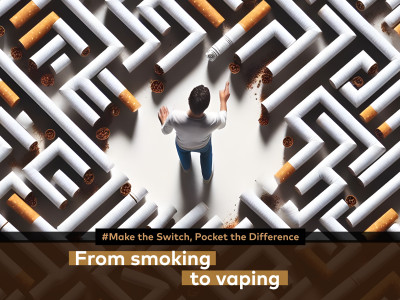In May, Farsalinos and Vassilis Voudris published a paper in Food and Chemical Toxicology titled ‘Do flavouring compounds contribute to aldehyde emissions in e-cigarettes?’ In it, they stated:
- A recent study found that flavourings are the major source of aldehyde emissions in e-cigarettes.
- This replication study found aldehyde emissions lower by up to 589-fold compared to the previous report.
- Unflavoured liquids also emitted aldehydes using the same e-cigarette devices.
- Minimal differences were observed between flavoured and unflavoured liquids.
Despite detecting formaldehyde present, Farsalinos and Voudris wrote: “the absolute levels were minimal.”
Khlystov and Samburova are clearly smarting from previous criticism and issued a letter attacking Farsalinos and Voudris: “Our purpose is to point out and/or correct inconsistencies and inaccuracies in that paper.”
Laughably, the non-experts on vaping state: “the methods used by Farsalinos and coworkers[sic] that are not suitable for e- cigarette aerosols studies,” and “Farsalinos and Voudris also make several misleading and outright false statements.”
Khlystov and Samburova go on to give a limp justification for their adoption of a flawed testing protocol and heap further insults onto Farsalinos and Voudris, implying they had secret motives for wanting to debunk experiments that discovered vast quantities of formaldehyde.
Dr Farsalinos produced a fourteen-page document by way of response.
“One of the major issues was the lack of verification that realistic use conditions were examined in the laboratory settings and that dry puffs were avoided. This phenomenon, which every e-cigarette user knows, understands and detects, has been largely neglected by researchers,” he writes. “A systematic review identified only 4 out of the 32 studies to have controlled the experimental conditions for the generation of dry puffs.”
He states that the only satisfactory way to ensure test conditions meet normal vaping conditions is to ask “experienced vapers to test the e-cigarette equipment (devices and liquid) at the power settings and puffing parameters that will be used in the laboratory.”
Farsalinos points out that different coils heat at different rates and that wattage alone is no indication of the potential for overheating. Secondly, that the time between puffs relies on the wick being able to convey liquid to the coil fast enough. Thirdly, that not puffing enough at high power settings over a longer time frame will also result in a dry-burn condition.
Next, the focus on using old, dated atomisers for experiments is one that is destined to fail, especially if using conditions replicating direct lung inhales. He emphasises that modern atomisers are required for such research.
“Khlystov and Samburova seem to consider power as the only parameter determining aldehyde emissions, ignoring other important characteristics such as the design of the atomizers and consistency in production quality” – Farsalinos
But then Konstantinos Farsalinos turns the screw: “The letter by Khlystov and Samburova includes several irrelevant, invalid and confusing arguments and comparisons.”
“They failed to notice that the replication experiments and analyses were performed in the same laboratory as the Gillman et al. (2016) study. Gillman and Enthalpy Analytical laboratory were clearly mentioned in the “Materials and Methods” and in the “Acknowledgements” section of our study manuscript as the laboratory that performed the replication experiments.”
“Additionally, since Khlystov and Samburova cite the study by Sleiman et al. (2016), I take the opportunity to clarify that the experiments of our replication study (Farsalinos et al., 2018b) were also performed in the same laboratory and in fact Gillman was a co-author in that study.”
He contends that any debate from Khlystov and Samburova about the performance and emissions of CE4 atomisers is irrelevant. As we all appreciate, CE4s haven’t been used in any numbers since the early days of vaping and are all but obsolete.
Farsalinos says Khlystov and Samburova are “highly inconsistent in accepting or rejecting measurements”, guilty of “selectively accepting results based on the values reported,” and “should review the literature very carefully and should properly understand the complexities and the different parameters that could affect study outcomes before rushing to unjustified and insulting conclusions about other scientists.”
Ouch!
Then, having been rebuked about the laboratory Farsalinos used and the accreditation Khlystov and Samburova assumed it to have, he replied: “Again, the authors of the letter should have been more careful and should have read the cited document which presents the accreditation of the laboratory.”
“It is surprising that Khlystov and Samburova cite in their letter several studies which completely reject their study findings” - Farsalinos
Farsalinos lists off the studies cited by Khlystov and Samburova (which they mistakenly believed supported their position. He destroys their position by going through he results of the studies – highlighting how the data contradicts the dubious levels Khlystov and Samburova discovered.
Farsalinos again lays into the pair for their hit and miss methodology, that their finding “has never been documented in any other study,” that serious questions are raised about the validity of their study, “to the point that they should consider the possibility of retracting their paper.”
Finally, Farsalinos rounds on just one of the pair: “it is important to notice the conduct of Dr Khlystov, who repeatedly denied reporting the liquid brand they used in the experiments in both private and public requests. I will let readers judge on this behaviour.”
He concludes:
- The arguments used by Khlystov and Samburova have no scientific basis
- They are citing studies which strongly reject their study findings
- Some of their citations are in perfect agreement with our findings
- They are inconsistent in accepting in one case and rejecting in another
- They compare studies evaluating dry puffs with their study where no dry puffs were created
- They make scientifically unsubstantiated and unjustified assumptions
- They seem to underestimate the complexity of the e-cigarette functional parameters
- Most importantly, their findings are inconsistent with current literature and cannot be attributed to dry puffs, and this raises even more questions about their scientific validity and makes the call for retraction more relevant and justified
It’s a damning destruction of the experiment and arguments from Khlystov and Samburova. More than academic point scoring, we hope that other researchers will read Farsalinos’ response and incorporate it into their future research planning stage.
Dave Cross
Journalist at POTVDave is a freelance writer; with articles on music, motorbikes, football, pop-science, vaping and tobacco harm reduction in Sounds, Melody Maker, UBG, AWoL, Bike, When Saturday Comes, Vape News Magazine, and syndicated across the Johnston Press group. He was published in an anthology of “Greatest Football Writing”, but still believes this was a mistake. Dave contributes sketches to comedy shows and used to co-host a radio sketch show. He’s worked with numerous vape companies to develop content for their websites.
Join the discussion
Doctors call for ban
Doctors call for prescription-only vapes in a letter to The Times under the guise of protecting children – ignoring the impact a similar approach has had in Australia
Council Demands Disposable Ban
Sheffield City Council has written to the Secretary of State to demand that the government bans disposable single-use vapes
CoEHAR Writes to the European Commissioner for Health
The Centre of Excellence for the acceleration of Harm Reduction has written a letter to the European Commissioner for Health asking for a redefinition of anti-smoking policies
Stolen Samsung Warning
Lawyers acting on behalf of Samsung are reminding us not to sell you any of their batteries in case they’re used for anything and order us to warn you about stolen batteries because reasons












